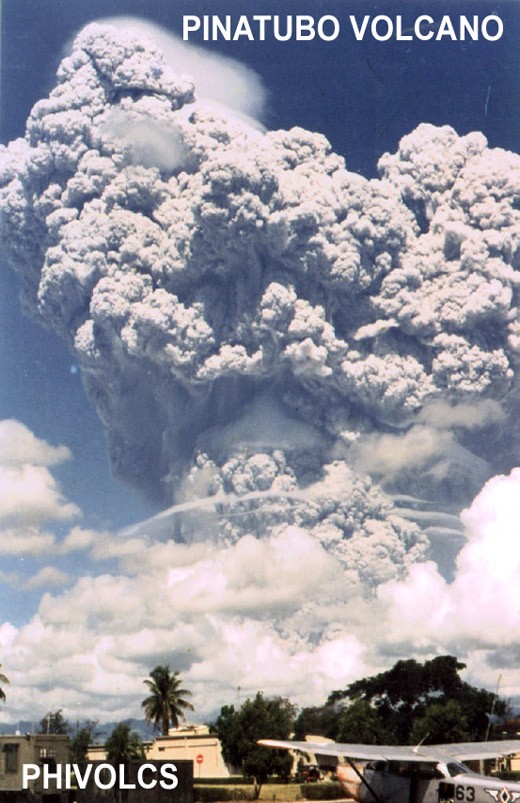The Philippine Institute of Volcanology and Seismology – Department of Science and Technology (PHIVOLCS-DOST) enjoins the nation in commemorating the 1991 Pinatubo Eruption on its 25th anniversary this June 2016.


Nine months after the catastrophic 16 July 1990 M7.8 Luzon Earthquake, Pinatubo ended about 400 years of quiescence on 2 April 1991 with a series of steam-driven eruptions from vents in its upper flanks.
This was followed in quick succession by the sighting of a lava intrusion on 7 June and powerful explosive eruptions that began on 12 June and culminated climactically on 15 June.
The paroxysm of 15 June propelled a 40 kilometer-high Plinian eruption column with a massive umbrella cloud that blanketed ash over 2,000 square kilometers of land in Luzon.
Ash rained further across 4 million square kilometers of the South China Sea and Southeast Asia.
Thick ashfall, soaked and made heavier by the passage of Typhoon Yunya (local name Diding), caused major infrastructural and roof collapse damages in the adjoining provinces of Zambales, Pampanga and Tarlac that straddle Pinatubo. Airborne volcanic ash paralyzed aviation in East Asia for days.
Deadly pyroclastic flows, high-velocity mixtures of hot gas, fragmented rock and ash, rushed down all sides of the summit to distances of 16 kilometers, burying major river valleys in hundred meters of hot volcanic debris.
These would sooner and later spawn secondary explosions and far-reaching hazardous lahars across five major river systems draining the volcano during heavy and prolonged rains. After the climactic eruption, discrete but minor explosions occurred until September 1991. From July to September 1992, a lava dome was quietly erupted within the newly-formed, 2.5 kilometer-diameter summit caldera. A large caldera lake would soon evolve and break out a decade later. By the end of the 1991 unrest, a total of 5.5 cubic kilometers of magma had been discharged, and Pinatubo’s eruption would become the second largest in the 20th century.
In Pinatubo’s wake, nearly 250,000 families were seriously affected and the indigenous Aeta people who called Pinatubo their god and its flanks their home completely displaced. As per records of the Office of Civil Defense (OCD), the eruption directly incurred 847 deaths, 184 injuries and 23 missing persons.
An estimated Php12.5B worth of damages to properties, agricultural lands, water ways, and infrastructure would economically cripple the Pinatubo region for a few but significant years.
But eruption was soon succeeded by an equally destructive crisis – a decade of fearsome lahars with every typhoon and episode of intense rainfall. The largest of these lahars, the 1993 Typhoon Kadiang, the 1994 Cutuno Lake breakout and the 1995 Typhoon Mameng, collectively dumped more than 200 million cubic meters of debris on riverine towns and cities of Pampanga and Zambales, while killing thousands in their course.
While the threat of lahars diminished in the following decade, large volumes of sediment have accumulated behind river impoundments and dikes, requiring vigilance against sudden breakout and remobilization to this day.
The 1991 Pinatubo eruption also had far-reaching global environmental impacts. Fine volcanic ash circulated the globe for three weeks after the paroxysmal eruption and attained global coverage by the end of one year. A total of 20 megatons of volcanic SO2 pumped into the earth’s stratosphere produced enough aerosol that forced short-lived climate cooling and decrease in global temperatures by 0.5C between 1992 and 1993. Pinatubo aerosol also depleted earth’s ozone layer at unprecedented rates in 1991 and enlarged the Southern Hemisphere’s ozone hole to an unprecedented size in 1992. By and large, the eruption stirred up huge scientific interest and research, not only in the eruptive behavior and hazards of active volcanoes, but particularly on the role of large volcanic eruption-forcing on global climate change.
The Pinatubo crisis also brought to the forefront the importance of scientists, disaster managers, local governments, and various national government agencies as well as armed forces working together for effective emergency management.
PHIVOLCS, led by its late former director Dr. Raymundo Punongbayan, and the US Geological Survey – Volcano Disaster Assistance Program (USGS VDAP), led by Dr. Christopher Newhall, forged a scientific collaboration that put forth the body of basic scientific information, instrumental monitoring, communication tools and decision-making processes that proved to be ultimately life-saving. For many years since, scientists, disaster officials and other practitioners in the field of volcanic crisis mitigation worldwide adopt and ascribe to the work accomplished in Pinatubo as best practices. The most important of these include the application of volcanic hazard maps, real-time seismic and volcanic SO2 monitoring; community-based information dissemination; the use of documentaries for communicating hazards; the Volcano Alert Level Scheme and other protocols for communicating hazards and inter-agency coordination. Pinatubo’s eruption thus set the standard for effective and successful volcanic crisis management.
While Pinatubo’s unrest brought untold hardship and destruction for many years, it has also underscored the immense fortitude of the Filipino people in overcoming adversity. On this 25th anniversary of the 1991 Pinatubo eruption, PHIVOLCS celebrates with the nation for successfully persevering through its long painful aftermath. As we all look back and remember the hardships and tragedies endured, we also look forward and reinforce the lessons learned, the learnings gained and the friendships forged in this crucible of events. PHIVOLCS continues its work to vigilantly monitor and seek scientific understanding of Pinatubo Volcano, to effectively raise awareness among stakeholders and to mainstream the use of scientific data in living with the volcano safely. (from Phivolcs)
